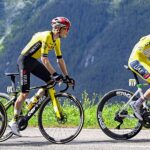In this week’s AIRmail newsletter, The Outer Line takes an in-depth look at: Changing media rights, where is Lappartient focused? Worlds get going, is there really a “youth movement” in cycling? New doping accusations…
# Catch up on pro cycling – and its context within the broader world of sports – with AIRmail … Analysis, Insight and Reflections from The Outer Line. You can subscribe to AIRmail here, and check out The Outer Line’s extensive library of articles on the governance and economics of cycling here. #
Key Takeaways:
Developments in Sports Media Rights – Implications for Cycling
Lappartient Would Resign UCI Role If He Wins IOC Presidency
World Championships Underway
Is There Really a Youth Movement in Cycling, or Not?
New Doping Positives
Amateur Athletics Is Disappearing
Cycling needs media coverage
We recently discussed the intersection of broadcast media rights and sports enterprise value ‒ a phenomenon we’re all too familiar with in pro cycling. Some sports have accelerated global growth with upscaled media deals, like the NFL and F1, but others have hit walls due to the unique market for their league or sport. We pointed to the example of France’s Ligue 1, which saw its media rights deal cut in half this summer in contrast to exponential growth in other national premier soccer club leagues like the ELP, and now in the U.S., prominent team owners are voicing their concerns about the NBA’s new $77+ billion dollar multi-party deal that creates new exclusivities for content delivery, but in many cases prevents fans in local region markets from being able to watch their teams play on any channel without purchasing multiple subscriptions. That latter point regarding local region market availability is one which plagues pro cycling as well, but in the macro view, is the current escalation in media rights pricing wars sustainable, or headed for a major correction?
TV money…
NFL success aside, the NBA offers clues to the economic reality. It has suffered declining viewership, and analysts believe its long season reduces the broadcast product scarcity (a factor in the NFL’s success). Other sports like the EPL and NFL are cannibalizing fan interest, and the NBA’s younger target audience is consuming most of its sports content through social media instead of live feeds. And with NBA playoff ratings at nearly half of its prior peak, league President Adam Silver may have overplayed his hand – especially if ratings trend flat and a Ligue 1-type devaluation happens in the future. However, the new norm for sports media valuation is how the rights licensee capitalizes on market channels, without respect to the sport itself. Terrestrial and cable TV can only influence consumer behavior with ads, whereas streaming-only options like Amazon (Thursday Night Football, the MLS, and now NBA) focus on acquiring subscribers, which leads to more content and consumer goods sales through the sports-enhanced ecommerce relationship. The NBA might become the new bellwether, but pro cycling may fall into a middle ground – dependent on regional importance for content valuation like week-long tours and semi-classics, but susceptible to revenue loss due to regional content restrictions. How we break that “cycle” may come down to whether the sport’s organizers are willing to aggregate content licensing for the greater good, or continue fractioning content licenses and delay revenue channel opportunities.
David Lappartient from UCI to IOC
This week, UCI President David Lappartient formally and publicly confirmed that were he to win the Olympic Presidency, he would immediately resign his position in cycling, as well as his leadership role at CNOSF – the French National Olympic and Sports Committee. As reported earlier, given that Lappartient’s seat on the IOC is a direct result of his Presidency position at the UCI, it is not quite clear how the logistics would work for him resigning that position – though similar technicalities hamper the potential presidency of several other of the seven candidates for the position. As one report put it, “the center-right lawmaker seems poised to make a competitive run with the Paris 2024 Olympics in his back pocket and the 2030 Alps as his calling card, knowing quite well that the road ahead may hide treacherous turns and quite a few surprises.” As mentioned last week, it seems fairly clear that, were Lappartient to bail out, he would be replaced by current UCI Vice President Enrico Della Casa. However, it also seems reasonable to ask what will happen should Lappartient not win the IOC Presidency, an outcome which seems more likely, despite his apparent level of support from outgoing President Thomas Bach. Lappartient has now made it clear that he has ambitions and objectives well beyond the UCI, so it’s reasonable to ask how long he might remain even if doesn’t win the IOC role.
Another big win for Remco Evenepoel
The UCI Road Cycling World Championships kicked off in Zürich over the weekend, with Remco Evenepoel and Grace Brown winning their respective time trial titles. These wins weren’t necessarily surprising, but they were of note – considering that both riders won the event in the Olympics as well, becoming the first riders to win both the World and Olympic time trial titles in the same year since professionals – and the individual event – were added to the Atlanta games in 1996. This pair of wins underscored just how large the gulf is between the men’s and women’s sides of the sport. Evenepoel is one of the sport’s most highly-paid stars and on the rise in his career, while Brown, despite historic dominance in the time trial discipline and career-best form in 2024, is retiring from the sport at just 32. And the disparity is even clearer within the women’s side of the sport, with Brown quietly walking away while runner-up Demi Vollering is rumored to have been offered a contract worth €1 million per season and is on the rise to mainstream stardom after signing her partnership deal with Nike earlier this year.
The next generation – Paul Seixas
With the Decathlon-AG2R signing of 17-year-old French sensation Paul Seixas (who took the junior world time trial title), the sport continues its obsession with finding the latest young talent who will one day presumably replace the current stars of the sport. The team is a clear leader in regard to its youth program and feeder system to lock in top talent. Meanwhile, other teams, like Ineos, who lack the same infrastructure, are increasingly finding themselves on the outside looking in. And as neo-pro contracts get longer, Ineos’ and other teams’ strategies of simply having the cash to sign young riders away from smaller teams is no longer viable; missing out on too many emerging stars when they first turn pro can, over the longer term, be crushing for a team’s prospects. Highlighting just how drastically things have shifted in recent years, Pablo Castrillo, the 23-year-old Equipo-Kern Pharma rider who broke out with two stage wins at the recent Vuelta, apparently agreed in principle to a deal with Ineos after his current deal expired at the end of 2024. However, despite being represented by Giuseppe Acquadro, who has historically provided Ineos with a steady stream of riders, the bloated bureaucracy at the team caused the wheels to turn slow enough that Castrillo still isn’t under contract, and he now appears to be on the verge of signing a three-year deal with Movistar.
Juan Ayuso not living up to expectation
But even as teams flock to sign tomorrow’s presumed superstars, recent winners of the biggest races are actually getting slightly older. For example, not a single Grand Tour was won by a rider eligible to win the Young Riders Jersey in the last two seasons; the average age has been 29 years. Compare this to the 2021 season, where two Grand Tours were won by youth classification winners, and the average age of Grand Tour winners was 26 years old. Meanwhile, prior “wunderkinds” like 22-year-old Juan Ayuso and 21-year-old Cian Uijtdebroeks are struggling. Ayuso has yet to match the overall podium he took at the 2022 Vuelta a España, and Uijtdebroeks recently called an end to his extremely disappointing 2024 campaign citing illness and “numb legs” (and not his disruptive mid-contract forced transfer from Bora-Hansgrohe to Visma-Lease a Bike). Teams may therefore not want to lean too heavily on top youth prospects for instant results; the wave of young, inexperienced riders winning the sport’s biggest races just a few seasons ago may have more to do with a handful of abnormally talented riders turning pro at the same time (Pogačar, Bernal, etc.) rather than a fundamental change in the fabric of the sport. After all, the increase in the average of all major race winners (aside from elder statesman Primož Roglič) is almost solely due to Tadej Pogačar, Jonas Vingegaard, Remco Evenepoel, and Mathieu van der Poel all getting older while still winning a massive share of the sport’s biggest races.
Wout Van Aert with Visma for life
Team Visma-Lease a Bike this week announced that its superstar all-round rider Wout Van Aert had signed a “lifetime contract” – agreeing to stick with the team for the rest of his career. To our knowledge, this is the first time that such a contract has been signed, and it clearly underlines both his critical importance to, and his true compatibility with his team. But the event also once again raises questions about what – if anything – a signed contract actually means these days in pro cycling. As we have discussed over the years, and particularly with reference to the recent cases of Uijtdebroeks and Roglič, contracts seem to be in force and recognized until they aren’t. In other words, as is often said in the business world, contracts are made to be broken; they signal an intent, but just as in a marriage, that intent can always change. And the longer the contract, the more likely it is to be broken. We have the sense that in Van Aert’s case, at age 30, his contract will most likely hold. But as veteran cycling commentator The Inner Ring put it in a comprehensive review of the current situation, “a contract may only be valid for as long as both sides want it to be so.”
Doping news is never far away
Two EPO positives in pro cycling during September has many of the sport’s observers asking, “Is EPO making a comeback?” The answer is not a simple yes or no regarding EPO’s continued shadow over the world of endurance athletics; in 2024 alone, there have been 30+ positives for various analogs of EPO in athletics, primarily among Kenyan and other East African distance runners. Other recent high-profile cases outside of cycling have occurred in triathlon. But with two cycling cases for the CERA version of EPO, we have to consider the following factors: CERA is easily detected as it lingers for a month or more due to its unique formulation (prolonged effects with fewer doses). Any athlete in a sport with anti-doping tests would be an idiot to knowingly use this shortcut. However, it could be that some CERA is leaking into the black market relabeled as EPO Alfa which is less detectable, and that could mean that informants, law enforcement intel, and targeted testing are catching these riders. And given the lack of investment in testing science and relatively low number of athletes who are actually tested, dependence on intel and whistleblowing is becoming an over-reliance. More to the point, EPO is one of those medications which is produced in such high quantities relative to the number of patients with a diagnosis to use it, it is inevitable that it gets diverted for abuse. So, is EPO making a comeback? No, it has been in cycling since at least 1988 and not exiting the dialogue anytime soon.
Is EPO use on the way back?
The ongoing battle between athletes and the NCAA for athlete rights and sports revenue sharing and equity has progressed far beyond the dismantling of what we previously called the “amateur” sporting framework. In a well-balanced analysis, a judge (who previously ruled in the “O’Bannon” case, which set the Name/Image/Likeness movement into motion) has told the litigants in the current House, Carter and Hubbard antitrust case to “go back to the drawing board.” The proposed House settlement “explicitly calls for colleges to pay athletes for media rights, ticket sales sponsorships and NIL.” The athletes have a very narrow window of NCAA eligibility in which to be rewarded for their athletic services to a university, and the judge is essentially stating that the NCAA can’t have it both ways – as both the employer and the arbiter of fair market value. As the article surmises, “…fair market value is notoriously difficult to assess in the NIL space … (and) the new framework could deprive athletes of NIL opportunities, making them worse off by the settlement.” Niche collegiate club sports are just beginning to benefit from NIL investment and if that accelerates after the House ruling – perhaps to the point that university clubs can develop talent around a fully-supported program and even compete for talent via NIL enticements – there’s little reason to think U.S. cycling couldn’t also benefit from a better-financed and progressive collegiate racing framework.
US collegiate cycling could use the money
# Catch up on pro cycling – and its context within the broader world of sports – with AIRmail … Analysis, Insight and Reflections from The Outer Line. You can subscribe to AIRmail here, and check out The Outer Line’s extensive library of articles on the governance and economics of cycling here. #
The post Changing Media Rights, Where is Lappartient Focused? Worlds Get Going; Is There Really a “Youth Movement” in Cycling? New Doping Accusations… appeared first on PezCycling News.




